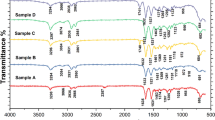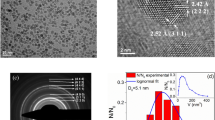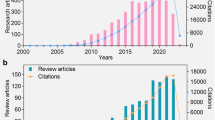Abstract
The thermal treatment of nanostructured materials to improve their properties generally results in undesirable aggregation and sintering. Here, we report on a novel wrap–bake–peel process, which involves silica coating, heat treatment and finally the removal of the silica layer, to transform the phases and structures of nanostructured materials while preserving their nanostructural characteristics. We demonstrate, as a proof-of-concept, the fabrication of water-dispersible and biocompatible hollow iron oxide nanocapsules by applying this wrap–bake–peel process to spindle-shaped akagenite (β-FeOOH) nanoparticles. Depending on the heat treatment conditions, hollow nanocapsules of either haematite or magnetite were produced. The synthesized water-dispersible magnetite nanocapsules were successfully used not only as a drug-delivery vehicle, but also as a T2 magnetic resonance imaging contrast agent. The current process is generally applicable, and was used to transform heterostructured FePt nanoparticles to high-temperature face-centred-tetragonal-phase FePt alloy nanocrystals.
This is a preview of subscription content, access via your institution
Access options
Subscribe to this journal
Receive 12 print issues and online access
$259.00 per year
only $21.58 per issue
Buy this article
- Purchase on Springer Link
- Instant access to full article PDF
Prices may be subject to local taxes which are calculated during checkout





Similar content being viewed by others
References
Kostorz, G. (ed.) Phase Transformations in Materials (Wiley-VCH, Weinheim, 2001).
Burstein, G. T., Hutchings, I. M. & Sasaki, K. Electrochemically induced annealing of stainless-steel surfaces. Nature 407, 885–887 (2000).
Sundaram, S. K. & Mazur, E. Inducing and probing non-thermal transitions in semiconductors using femtosecond laser pulses. Nature Mater. 1, 217–224 (2002).
Jacobs, K., Zaziski, D., Scher, E. C., Herhold, A. B. & Alivisatos, A. P. Activation volumes for solid-solid transformations in nanocrystals. Science 293, 1803–1806 (2001).
Sun, S., Murray, C. B., Weller, D., Folks, L. & Moser, A. Monodisperse FePt nanoparticles and ferromagnetic FePt nanocrystal superlattices. Science 287, 1989–1992 (2000).
Budai, J. D. et al. Controlling the size, structure and orientation of semiconductor nanocrystals using metastable phase recrystallization. Nature 390, 384–386 (1997).
Zeng, H., Li, J., Liu, J. P., Wang, Z. L. & Sun, S. H. Exchange-coupled nanocomposite magnets by nanoparticle self-assembly. Nature 420, 395–398 (2002).
Yin, Y., Erdonmez, C., Aloni, S. & Alivisatos, A. P. Faceting of nanocrystals during chemical transformation: From solid silver spheres to hollow gold octahedra. J. Am. Chem. Soc. 128, 12671–12673 (2006).
Kim, D. et al. Synthesis of hollow iron nanoframes. J. Am. Chem. Soc. 129, 5812–5813 (2007).
Liang, H.-P. et al. Pt hollow nanospheres: facile synthesis and enhanced electrocatalysts. Angew. Chem. Int. Edn 43, 1540–1543 (2004).
Kim, S.-W., Kim, M., Lee, W. Y. & Hyeon, T. Fabrication of hollow palladium spheres and their successful application to the recyclable heterogeneous catalyst for suzuki coupling reactions. J. Am. Chem. Soc. 124, 7642–7643 (2002).
Lou, X. W., Wang, Y., Yuan, C., Lee, J. Y. & Archer, L. A. Template-free synthesis of SnO2 hollow nanostructures with high lithium storage capacity. Adv. Mater. 18, 2325–2329 (2006).
Yin, Y. et al. Formation of hollow nanocrystals through the nanoscale kirkendall effect. Science 304, 711–714 (2004).
Gasparac, R., Kohli, P., Mota, M. O., Trofin, L. & Martin, C. R. Template synthesis of nano test tubes. Nano Lett. 4, 513–516 (2004).
Grosso, D., Boissière, C. & Sanchez, C. Ultralow-dielectric-constant optical thin films built from magnesium oxyfluoride vesicle-like hollow nanoparticles. Nature Mater. 6, 572–575 (2007).
Dhas, N. A. & Suslick, K. S. Sonochemical preparation of hollow nanospheres and hollow nanocrystals. J. Am. Chem. Soc. 127, 2368–2369 (2005).
Yoon, S. B. et al. Fabrication of carbon capsules with hollow macroporous core/mesoporous shell structures. Adv. Mater. 14, 19–21 (2002).
Chen, J., Xu, L., Li, W. & Gou, X. α-Fe2O3 nanotubes in gas sensor and lithium-ion battery applications. Adv. Mater. 17, 582–586 (2005).
Shekhah, O., Ranke, W., Schüle, A., Kolios, G. & Schlögl, R. Styrene synthesis: High conversion over unpromoted iron oxide catalysts under practical working conditions. Angew. Chem. Int. Edn 42, 5760–5763 (2003).
Poizot, P., Laruelle, S., Grugeon, S., Dupont, L. & Tarascon, J.-M. Nano-sized transition-metal oxides as negative-electrode materials for lithium-ion batteries. Nature 407, 496–499 (2000).
Weissleder, R., Kelly, K., Sun, E. Y., Shtatland, T. & Josephson, L. Cell-specific targeting of nanoparticles by multivalent attachment of small molecules. Nature Biotechnol. 23, 1418–1423 (2005).
Bulte, J. W. M. & Kraitchman, D. L. Iron oxide MR contrast agents for molecular and cellular imaging. NMR Biomed. 17, 484–499 (2004).
Xu, C. et al. Dopamine as a robust anchor to immobilize functional molecules on the iron oxide shell of magnetic nanoparticles. J. Am. Chem. Soc. 126, 9938–9939 (2004).
Gu, H., Xu, K., Xu, C. & Xu, B. Biofunctional magnetic nanoparticles for protein separation and pathogen detection. Chem. Commun. 941–949 (2006).
Lee, I. S. et al. Ni/NiO core/shell nanoparticles for selective binding and magnetic separation of histidine-tagged proteins. J. Am. Chem. Soc. 128, 10658–10659 (2006).
Lee, J. H. et al. Artificially engineered magnetic nanoparticles for ultra-sensitive molecular imaging. Nature Med. 13, 95–99 (2007).
Son, S. J., Reichel, J., He, B., Schuchman, M. & Lee, S. B. Magnetic nanotubes for magnetic-field-assisted bioseparation, biointeraction, and drug delivery. J. Am. Chem. Soc. 127, 7316–7317 (2005).
Jia, C.-J. et al. Single-crystalline iron oxide nanotubes. Angew. Chem. Int. Edn 44, 4328–4333 (2005).
Liu, Z. et al. Single crystalline magnetite nanotubes. J. Am. Chem. Soc. 127, 6–7 (2005).
Peng, S. & Sun, S. Synthesis and characterization of monodisperse hollow Fe3O4 nanoparticles. Angew. Chem. Int. Edn 46, 4155–4158 (2007).
Bang, J. H. & Suslick, K. S. Sonochemical synthesis of nanosized hollow hematite. J. Am. Chem. Soc. 129, 2242–2243 (2007).
Chen, M., Tang, B. & Nikles, D. E. Preparation of iron nanoparticles by reduction of acicular β-FeOOH particles. IEEE Trans. Magn. 34, 1141–1143 (1998).
Graf, C., Vossen, D. L. J., Imhof, A. & van Blaaderen, A. A general method to coat colloidal particles with silica. Langmuir 19, 6693–6700 (2003).
Steinhart, M., Wehrspohn, R. B., Gösele, U. & Wendorff, J. H. Nanotubes by template wetting: A modular assembly system. Angew. Chem. Int. Edn 43, 1334–1344 (2004).
Bondioli, F., Ferrari, A. M., Leonelli, C. & Manfredini, T. Synthesis of Fe2O3/silica red inorganic inclusion pigments for ceramic applications. Mater. Res. Bull. 33, 723–729 (1998).
Luo, Y., Lee, S. K., Hofmeister, H., Steinhart, M. & Gösele, U. Pt nanoshell tubes by template wetting. Nano Lett. 4, 143–147 (2004).
da Silva, S. W. et al. Raman spectroscopy of cobalt ferrite nanocomposite in silica matrix prepared by sol–gel method. J. Non-Cryst. Solids 352, 1602–1606 (2006).
Booser, D. J. & Hortobagyi, G. N. Anthracycline antibiotics in cancer therapy: focus on drug resistance. Drugs 47, 223–258 (1994).
Geng, Y. et al. Shape effects of filaments versus spherical particles in flow and drug delivery. Nature Nanotechnol. 2, 249–255 (2007).
Sun, S. Recent advances in chemical synthesis, self-assembly, and applications of FePt nanoparticles. Adv. Mater. 18, 393–403 (2006).
Lee, D. C., Mikulec, F. V., Pelaez, J. M., Koo, B. & Korgel, B. A. Synthesis and magnetic properties of silica-coated FePt nanocrystals. J. Phys. Chem. B 110, 11160–11166 (2006).
Hyun, C., Lee, D. C., Korgel, B. A. & de Lozanne, A. Micromagnetic study of single-domain FePt nanocrystals overcoated with silica. Nanotechnology 18, 055704 (2007).
Varanda, L. C. & Jafelicci, M. Self-assembled FePt nanocrystals with large coercivity: reduction of the fcc-to-L1(0) ordering temperature. J. Am. Chem. Soc. 128, 11062–11066 (2006).
Kang, S., Harrell, J. W. & Nikles, D. E. Reduction of the fcc to L1(0) ordering temperature for self-assembled FePt nanoparticles containing Ag. Nano Lett. 2, 1033–1036 (2002).
Dai, Z. R., Sun, S. H. & Wang, Z. L. Phase transformation, coalescence, and twinning of monodisperse FePt nanocrystals. Nano Lett. 1, 443–447 (2001).
Acknowledgements
T.H. acknowledges financial support by the Korean Ministry of Science and Technology through the National Creative Research Initiative Program of the Korea Science and Engineering Foundation (KOSEF).
Author information
Authors and Affiliations
Corresponding author
Supplementary information
Supplementary Information
Supplementary figures S1–S22 (PDF 4091 kb)
Rights and permissions
About this article
Cite this article
Piao, Y., Kim, J., Na, H. et al. Wrap–bake–peel process for nanostructural transformation from β-FeOOH nanorods to biocompatible iron oxide nanocapsules. Nature Mater 7, 242–247 (2008). https://doi.org/10.1038/nmat2118
Received:
Accepted:
Published:
Issue Date:
DOI: https://doi.org/10.1038/nmat2118



